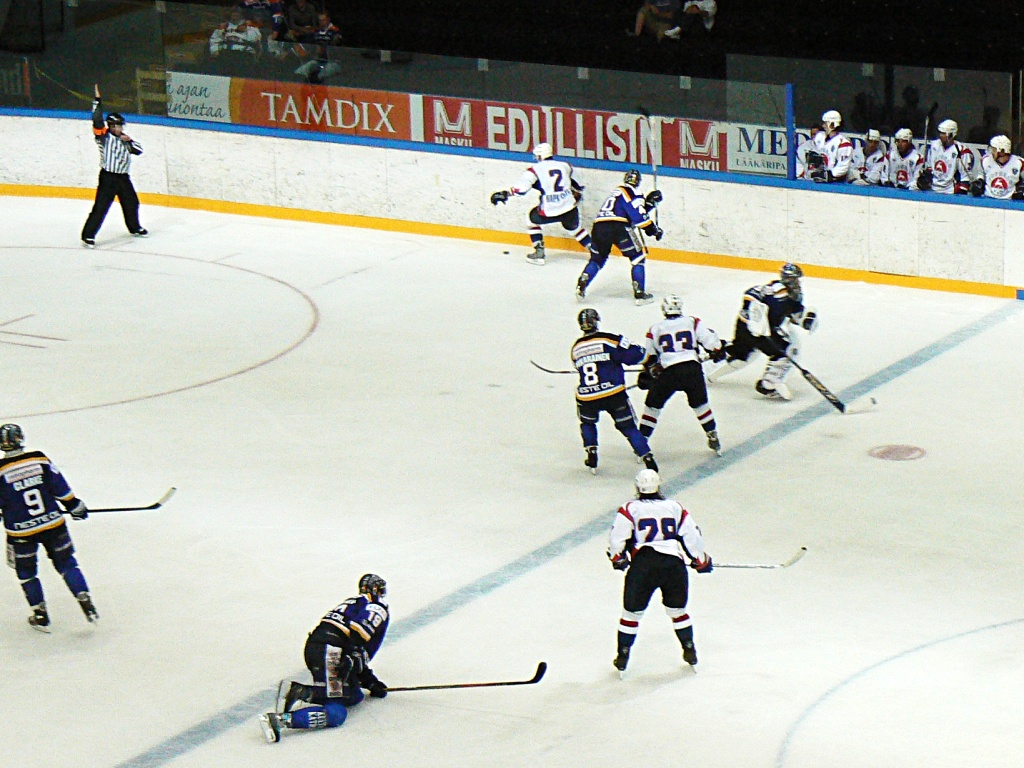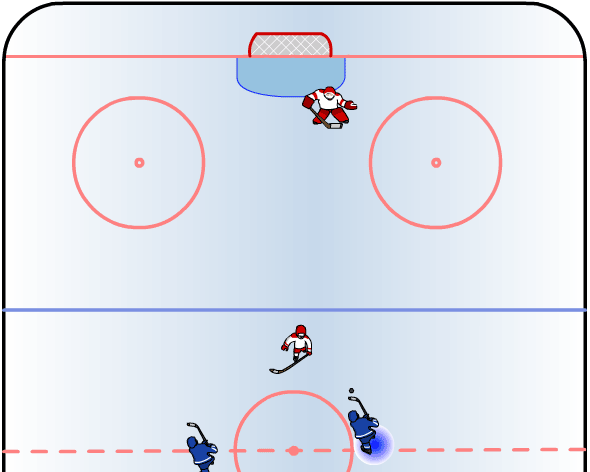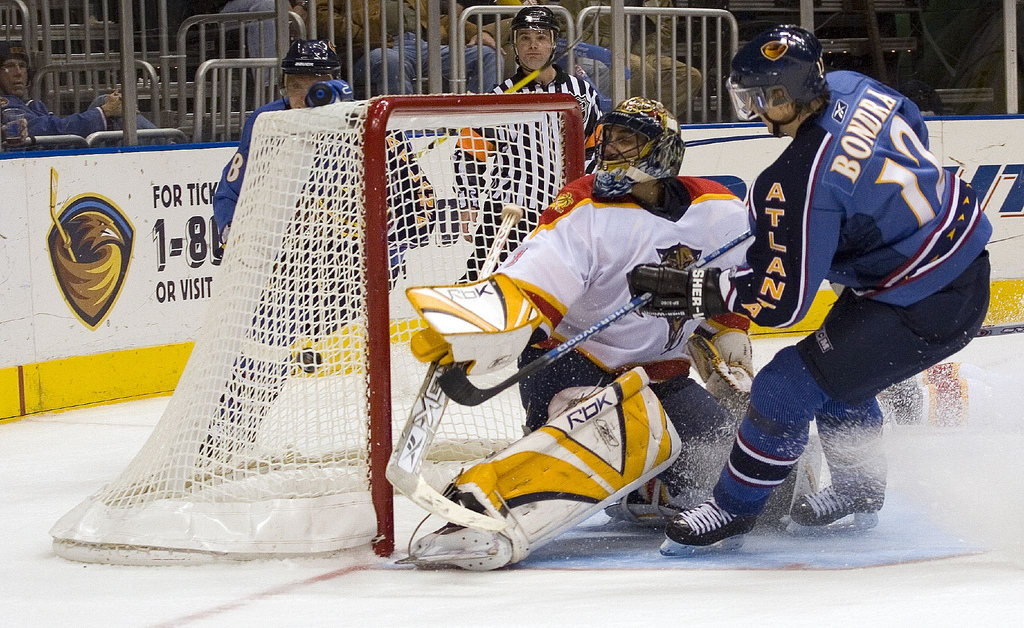|
Ove Dahlberg
Ove Dahlberg (12 April 1931 – 9 January 1997) was a Swedish ice hockey and soccer official. Having previously played a forward position in ice hockey, Dahlberg is considered one of the greatest European referees for his ability to read the game. He was inducted posthumously into the IIHF Hall of Fame in 2004 and into the Swedish Ice Hockey Hall of Fame in 2012. Career Dahlberg was born on 12 April 1931 in Surahammar, Sweden. He grew up as childhood friends with Ronald Pettersson, who also played hockey and was eventually inducted into the Hockey Hall of Fame. Dahlberg played ice hockey before beginning his refereeing career. He began as a forward before transitioning to defence. He played for Surahammars IF in the then-highest Swedish league Hockeyettan before making his Sweden national ice hockey team debut in 1954. He made his international debut at the 1962 Ice Hockey World Championships. In the 1960s, he was hired by the International Ice Hockey Federation (IIHF) to serve ... [...More Info...] [...Related Items...] OR: [Wikipedia] [Google] [Baidu] |
Surahammar
Surahammar ( or ) is a locality and the seat of Surahammar Municipality in Västmanland County Västmanland County ( sv, Västmanlands län) is a county or ''län'' in central Sweden. It borders the counties of Södermanland, Örebro, Gävleborg, Dalarna and Uppsala. The county also has a stretch of shoreline towards Mälaren (Sweden's ..., Sweden with 6,179 inhabitants in 2010. References Municipal seats of Västmanland County Swedish municipal seats Populated places in Västmanland County Populated places in Surahammar Municipality {{Västmanland-geo-stub ... [...More Info...] [...Related Items...] OR: [Wikipedia] [Google] [Baidu] |
FIFA World Cup Qualification
The FIFA World Cup qualification is a competitive match that a national association football team takes in order to qualify for one of the available berths at the final tournament of the (men's) FIFA World Cup. Qualifying tournaments are held within the six FIFA continental zones, each organized by their respective confederations: AFC (Asia), CAF (Africa), CONCACAF (North and Central America and the Caribbean), CONMEBOL (South America), OFC (Oceania), and UEFA (Europe). For each World Cup, FIFA decides the number of places in the finals allocated to each of the zones, based on the numbers and relative strengths of the confederations' teams. As a courtesy, the host receives an automatic berth selection, as has happened with the immediate past tournament winner during much of the competition's history. All other finalists are determined on a standalone qualifying round achievement without regard to previous achievements. History The berths for the inaugural 1930 tourname ... [...More Info...] [...Related Items...] OR: [Wikipedia] [Google] [Baidu] |
Ice Hockey World Championships
The Ice Hockey World Championships are an annual international men's ice hockey tournament organized by the International Ice Hockey Federation (IIHF). First officially held at the 1920 Summer Olympics, it is the sport's highest profile annual international tournament. The IIHF was created in 1908 while the European Championships, the precursor to the World Championships, were first held in 1910. The tournament held at the 1920 Summer Olympics is recognized as the first Ice Hockey World Championship. From 1920 to 1968, the Olympic hockey tournament was also considered the World Championship for that year. The first World Championship that was held as an individual event was in 1930 in which twelve nations participated. In 1931, ten teams played a series of round-robin format qualifying rounds to determine which nations participated in the medal round. Medals were awarded based on the final standings of the teams in the medal round. In 1951, thirteen nations took part and we ... [...More Info...] [...Related Items...] OR: [Wikipedia] [Google] [Baidu] |
Division 3 (Swedish Ice Hockey)
Ice hockey in Sweden has a history going back to at least 1912 and is one of the country's most popular sports. The sport was first organized in the country by the Swedish Football Association (SvFF), which was a member of the IIHF in 1912. The ice hockey department of the SvFF eventually split off to become the Swedish Ice Hockey Association (SIHA) which today is still responsible for organizing Sweden's domestic leagues and its participation in tournaments internationally. The highest tier of men's ice hockey in Sweden, the SHL, brought in 1,974,388 spectators in the 2013–14 season, the highest overall attendance in Swedish sports. The SHL's average of 5,983 spectators per match is bested only by Allsvenskan, the country's top flight of association football. The first recorded official ice hockey game on Swedish soil was played at Stockholm Stadium on 30 January 1921 when IFK Uppsala defeated Berliner SC, 4–1. National teams Men's Often referred to by the nickname ... [...More Info...] [...Related Items...] OR: [Wikipedia] [Google] [Baidu] |
Västerås IK
Västerås IK (''Västerås Ishockey klubb'') is an ice hockey club from Västerås, Sweden. The team is currently playing in the second-tier league in Sweden, Hockeyallsvenskan. Västerås IK played 12 seasons in the top Swedish league Elitserien (1988–89 to 1999–00) before the club went bankrupt and merged with the junior club (Västerås IK Ungdom), which changed name to VIK Västerås HK in 2005. In 2018, after playing a year in tier three, Hockeyettan, the club changed it name back to the old name Västerås IK. History Västerås IK was founded in 1913 and started playing ice hockey in 1939. The ice hockey section of Västerås IK was later separated and was active until 2000, when the club folded and the A team was moved to the club Västerås IK Ungdom (English: ''junior''), which changed to its current name in 2018. Season-by-season ''This list features only the ten most recent seasons. For a more complete list, see List of VIK Västerås HK seasons.'' Famous pla ... [...More Info...] [...Related Items...] OR: [Wikipedia] [Google] [Baidu] |
Division 1 (Swedish Ice Hockey)
Hockeyettan is the third tier of ice hockey in Sweden. As of the 2015–16 season, the league consists of 46 teams divided geographically into four groups. Hockeyettan operates a system of promotion and relegation with HockeyAllsvenskan and Division 2. From 1944 to 1975, Division I was the highest league in the Swedish ice hockey system, but with the creation of Elitserien (now the SHL) in 1975, it became the second tier. Division I was further relegated to third-tier status in 1999 as HockeyAllsvenskan was spun off into a standalone league, but was frequently written as "Division 1" on the Internet, as it was pronounced "Division One". The league was renamed Hockeyettan for the 2014–15 season. Hockeyettan is the lowest tier to be organized by the Swedish Ice Hockey Association; all men's tiers below Hockeyettan are organized regionally. Format As of the 2015–16 season, the league consists of 48 teams divided into four groups of 12 geographically. The clubs meet each oth ... [...More Info...] [...Related Items...] OR: [Wikipedia] [Google] [Baidu] |
Division 2 (Swedish Ice Hockey)
Division II or Division 2 may refer to: Sports * NCAA Division II, an intermediate-level division of the National Collegiate Athletic Association * Division 2 (Swedish football) * Division 2 (Swedish ice hockey), the fourth tier of ice hockey in Sweden * Division 2 (Swedish women's football) * Division II (US bandy), the second-highest league for bandy in the United States * Division II (windsurf board), a class of windsurf board design * FFHG Division 2, ice hockey, France * Second Division, a list of divisions in various football leagues * Division II (NCRHA), a division of the National Collegiate Roller Hockey Association Other * Division No. 2, Manitoba, a region of Manitoba, Canada * Division No. 2, Saskatchewan, a census division within Saskatchewan, Canada * ''Tom Clancy's The Division 2'', a 2019 video game See also * 2nd Division (other), a list of military units and formations * B Division (other) * Division 1 (other) Division 1 and variants ... [...More Info...] [...Related Items...] OR: [Wikipedia] [Google] [Baidu] |
Penalty (ice Hockey)
A penalty in ice hockey is a punishment for an infringement of the rules. Most penalties are enforced by sending the offending player to a penalty box for a set number of minutes. During the penalty the player may not participate in play. Penalties are called and enforced by the referee, or in some cases, the linesman. The offending team may not replace the player on the ice (although there are some exceptions, such as fighting), leaving them short-handed as opposed to full strength. When the opposing team is said to be on a ''power play'', they will have one more player on the ice than the short-handed team. The short-handed team is said to be "on the penalty kill" until the penalty expires and the penalized player returns to play. While standards vary somewhat between leagues, most leagues recognize several common varieties of penalties, as well as common infractions. The statistic used to track penalties is called "penalty minutes" and abbreviated to "PIM" (spoken as single w ... [...More Info...] [...Related Items...] OR: [Wikipedia] [Google] [Baidu] |
Point (ice Hockey)
In ice hockey, point has three contemporary meanings. Personal stat A point is awarded to a player for each goal scored or assist earned. The total number of goals plus assists equals total points. The Art Ross Trophy is awarded to the National Hockey League (NHL) player who leads the league in scoring points at the end of the regular season. Team stat Points are also awarded to assess standings (or rankings). Historically, teams were awarded two points for each win, one point for each tie and no points for a loss. Such a ranking system, implemented primarily to ensure a tie counted as a "half-win" for each team in the standings, is generally regarded as British and/or European in origin and as such adopted by the National Hockey League which was founded in Canada where leagues generally used ranking systems of British origin. Awarding points in the standings contrasts with traditional American ranking systems favored in sports originating within the United States where today the m ... [...More Info...] [...Related Items...] OR: [Wikipedia] [Google] [Baidu] |
Assist (ice Hockey)
In ice hockey, an assist is attributed to up to two players of the scoring team who shot, passed or deflected the puck towards the scoring teammate, or touched it in any other way which enabled the goal, meaning that they were "assisting" in the goal. There can be a maximum of two assists per goal. The assists will be awarded in the order of play, with the last player to pass the puck to the goal scorer getting the primary assist and the player who passed it to the primary assister getting the secondary assist. Players who gain an assist will get one point added to their player statistics. Despite the use of the terms "primary assist" and "secondary assist", neither is worth more than the other, and neither is worth more or less than a goal. Assists and goals are added together on a player's scoresheet to display that player's total points. Special cases If a player scores off a rebound given up by a goaltender, assists are still awarded, as long as there is no re-possession by t ... [...More Info...] [...Related Items...] OR: [Wikipedia] [Google] [Baidu] |
Goal (ice Hockey)
In ice hockey, a goal is scored when the puck entirely crosses the goal line between the two goal posts and below the goal crossbar. A goal awards one point to the team attacking the goal scored upon, regardless of which team the player who actually deflected the puck into the goal belongs to (see also own goal). Typically, a player on the team attempting to score shoots the puck with their stick towards the goal net opening, and a player on the opposing team called a goaltender tries to block the shot to prevent a goal from being scored against their team. The term goal may also refer to the structure in which goals are scored. The ice hockey goal is rectangular in shape; the front frame of the goal is made of steel tube painted red (blue in the ECHL because of a sponsorship deal with GEICO) and consists of two vertical goalposts and a horizontal crossbar. A net is attached to the back of the frame to catch pucks that enter the goal and also to prevent pucks from entering it ... [...More Info...] [...Related Items...] OR: [Wikipedia] [Google] [Baidu] |
Season (sports)
In an organized sports league, a typical season is the portion of one year in which regulated games of the sport are in session: for example, in Major League Baseball the season lasts approximately from the last week of March to the last week of September. In other team sports, like association football or basketball, it is generally from August or September to May although in some countries - such as Northern Europe or East Asia - the season starts in the spring and finishes in autumn, mainly due to weather conditions encountered during the winter. A year can often be broken up into several distinct sections (sometimes themselves called seasons). These are: a preseason, a series of exhibition games played for training purposes; a regular season, the main period of the league's competition; the postseason, a playoff tournament played against the league's top teams to determine the league's champion; and the offseason, the time when there is no official competition. Preseason In ... [...More Info...] [...Related Items...] OR: [Wikipedia] [Google] [Baidu] |




